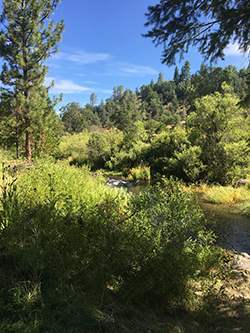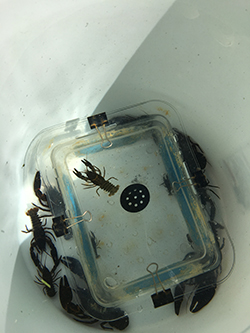
Rock Creek, where Shasta Crayfish were released by hand July 15.

Shasta Crayfish await delivery into their new home in Rock Creek. The Shasta Crayfish is a small- to medium-sized crayfish found only in northeast California.

Establishing populations of Shasta Crayfish in suitable water bodies that are inaccessible to invasive crayfish is the central effort in conserving the species.

The mix of 28 Shasta Crayfish introduced into Rock Creek included both juveniles and adults of varying sizes.
A 20-year, multiagency effort to find a safe haven for California’s only remaining native crayfish culminated recently with the release of 28 Shasta Crayfish (Pacifastacus fortis) into a restored section of Rock Creek in Shasta County.
The Shasta Crayfish has been in decline and under assault for decades from the pervasive, nonnative, invasive Signal Crayfish (Pacifastacus leniusculus), which not only outcompetes it for food and habitat but renders Shasta Crayfish females largely infertile through interbreeding. Found only in northeastern California, the Shasta Crayfish was listed as an endangered species by both the state and federal governments in 1988.
It was all smiles and optimism for a brighter future July 15, however, with the release of the 28 adult and juvenile Shasta Crayfish into a formerly dry, meadow portion of Rock Creek on property owned by Pacific Gas and Electric Company. That portion of Rock Creek, just six-tenths of a mile long, now flows with a reliable supply of cool, clear water with habitat enhancements that include rock clusters and riparian plantings.
Restoration of Rock Creek was completed in 2016 through a partnership with PG&E, CDFW, the U.S. Fish and Wildlife Service and the biological consulting firm Spring Rivers Ecological Sciences LLC.
Spring Rivers scuba divers collected Shasta Crayfish from the bottom of nearby Crystal Lake in June. Crystal Lake is believed to hold the most genetically robust population of Shasta Crayfish left in the wild but a population that’s also in decline as a result of the invading Signal Crayfish. The Shasta Crayfish were quarantined for 42 days before release into their new home.
Key to the Shasta Crayfish’s recovery as well as its biggest obstacle is establishing populations in waters inaccessible to the invasive Signal Crayfish. The refuge at Rock Creek was 20 years in the making by the time the site was identified, project proposals prepared and approved, permits secured, partnerships formalized, restoration work completed and the Shasta Crayfish translocated last month.
Restoration of the creek involved major construction removing a diversion dam upstream and rerouting a pipeline that supplied CDFW’s Crystal Lake Hatchery with water downstream. The location was deemed ideal as CDFW’s fish hatchery would block any Signal Crayfish in Crystal Lake from moving up into the restored portion of the creek.
In their new Rock Creek refuge, the Shasta Crayfish will be closely monitored. The hope is that they can serve as a sustainable, genetically diverse source population for future introductions.
CDFW Photos. Top Photo: Divers carefully released Shasta Crayfish by hand into their new home July 15. Prior to release, biologists measured and recorded their size and other data.
###
Media Contact:
Peter Tira, CDFW Communications, (916) 322-8908